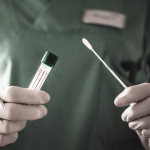The presence of DNA from high-risk human papillomavirus (HPV) types in the saliva can help detect certain head and neck cancers early, according to study results published in the Journal of Molecular Diagnostics.
Head and neck cancer refers to a variety of different malignancies involving the mouth, throat, tonsils, salivary glands, jaw, nose and sinuses. But the most common are cancers of the mouth and upper part of the throat (oropharynx), typically caused by high-risk HPV types.
One of the most common sexually transmitted infections, HPV triggers abnormal cell growth that can lead to cervical, genital, anal and oral cancers. Regular Pap smears and HPV testing have dramatically reduced the risk of cervical cancer, but there are currently no routine tests for early detection of oropharyngeal cancer, which has surpassed cervical cancer as the most common type of HPV-related cancer in the United States.
Given the difficulty of accessing all parts of the oropharynx, small cancerous growths can be hard to diagnose with imaging or other tests. These cancers can also metastasize early in the course of the disease.
“Despite the upsurge in HPV-driven [head and neck cancer], there are no early detection methods or screening strategies for this cancer type, unlike cervical cancer, which is caused by the same virus,” Chamindie Punyadeera, PhD, of the Queensland University of Technology, in Australia, said in a press release. “Biomarkers enabling early detection, monitoring and disease prognostication are warranted to combat the rising incidence of HPV-driven [oropharyngeal cancer].”
Punyadeera and colleagues evaluated the viability of assessing HPV DNA in saliva as a way to easily test for the virus. They also studied survival patterns among people with oropharyngeal cancer to determine if the presence of salivary HPV DNA could function as a predictive biomarker for prognosis.
The researchers examined the presence of HPV DNA in saliva from 491 people with primary (first diagnosis) head and neck cancers and 10 people with recurrent cancer. A subset of 215 people with oropharyngeal cancer were observed for five years.
Of the 491 people with initial or recurrent head and neck cancer, 43% tested positive for high-risk HPV DNA in their saliva; HPV type 16 wa detected in 92% of the HPV-positive samples. Most of those with HPV-driven head and neck cancers had oropharyngeal cancer, especially arising from the base of the tongue and the tonsils. Looking just at those with oropharyngeal cancer, 72% tested positive for HPV DNA in their saliva. Among those with HPV-16, some 81% had detectable salivary HPV DNA.
Among those followed over time, people with oropharyngeal cancers who tested positive for salivary HPV DNA had better survival outcomes than those who tested negative, with the median event-free survival period being about 17 years compared with about seven years, respectively.
“When the noninvasive nature and convenience of the collection are considered, salivary [high risk HPV] testing is an ideal mode of screening asymptomatic individuals and the long-term monitoring of HPV-driven [head and neck cancer patients,” said Punyadeera. “Our findings indicate that in the near future, salivary [high-risk HPV] testing will become part of routine clinical management for HPV-driven [oropharyngeal cancer] patients.”
While a simple saliva test could help detect oral cancer at an earlier, more treatable stage, prevention would be even better. The Gardasil 9 vaccine, which protects against nine high-risk HPV types, is recommended for adolescents—both girls and boys—at age 11 or 12, with catch up vaccination through age 26.
Click here to read the study in the Journal of Molecular Diagnostics.
Click here for more news about human papillomavirus.







Comments
Comments